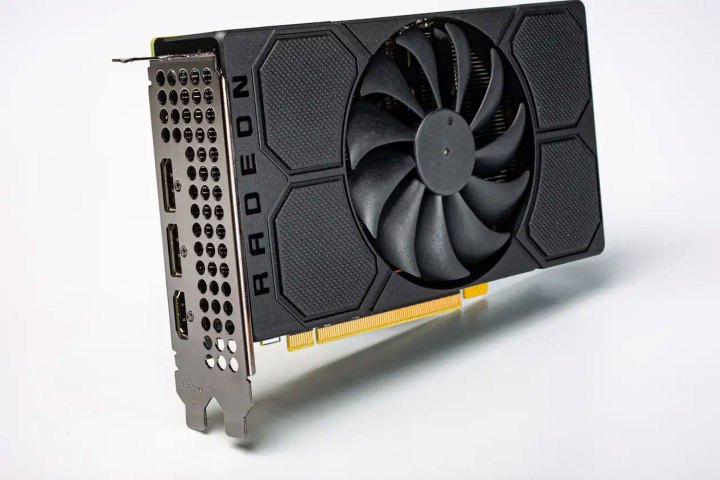
Early test results for an alleged AMD RX 5500 — an OEM version without any aftermarket cooling or overclocking — suggest that it would be roughly as powerful as an Nvidia GTX 1660, and slightly slower than an AMD RX 580 — though it would draw around 100w less power than the older AMD card. This suggests that it will be more than a match for its targeted competitor, the Nvidia GTX 1650, and potentially the new GTX 1650 Super, too.
AMD’s RX 5000 series of RDNA-based, Navi graphics cards has been stellar, albeit rather limited. The RX 5700 and 5700 XT launched in July and offer great competition for Nvidia’s RTX 2060 Super and the RTX 2070, as well as acting as feasible replacements for older high-end AMD cards, like the RX Vega 56, 64, and Radeon VII. But two cards do not a full-graphics-card range make. The RX 5500, 5500M, and 5500XT are expected to launch before the end of the year, and their performance potential is intriguing.
AMD has only released its own performance numbers for the RX 5500 so far, claiming that it was more capable than an RX 480, and much more so than a GTX 1060. A leaked sales guide for the card appeared online earlier this month, too, suggesting that the RX 5500 would absolutely crush the GTX 1650. The results Heise is quoting from its OEM RX 5500 sample suggest that this could well be the case.

Paired up with an Intel Core i7-8700K and 32GB of RAM, the RX 5500 was said to deliver a score of 12,111 points in 3DMark Fire Strike. In comparison, a factory overclocked RX 580 managed a score of 12,744, while a Gigabyte GTX 1660 OC managed 12,525. These results are similar to those found in a real-world gaming test of Shadow of the Tomb Raider, where the RX 5500, RX 580, and GTX 1660, scored 59 FPS, 65 FPS, and 69 FPS, respectively.
Although this might not seem like much of a generational upgrade when you consider that the Polaris-based RX 580 is two years old — and is itself a refresh of the RX 480 — the RX 5500 did achieve these scores with a power requirement of just 120w. That’s almost 100w less than the RX 580, and slightly less than the GTX 1660.
These results suggest that the RX 5500 will be a great competitor for the GTX 1650, if AMD prices it well. But the big risk for AMD here is invalidating its own lineup. It already has GTX 1650 and 1660 competitors in the form of RX 580, 590, and Vega 56 cards, even if they are woefully inefficient compared to the newer Nvidia GPUs.
However, if this RX 5500 is a GTX 1650 competitor, it could well be the new-gen replacement for the RX 570. If so, that gets far more exciting. The RX 570 goes for between $130 and $150, depending on the version you buy. If this card matches that price, the expanded Navi range holds a lot more potential. The alleged RX 5500 XT could be more competitive with the likes of the RX 590, and therefore 1660 Super, at more competitive prices. Those cards would offer a worthier upgrade over RX 500-series GPUs and when you factor in the added performance potential of third-party overclocked cards with better cooling and enhanced power, we could have some monstrous little GPUs at the entry-level of AMD’s RX 5000-generation.
Much of this is speculation at this time, with AMD being coy about anything but the RX 5500. But with AMD expected to flesh out its range of Navi cards before the unveiling of second-generation RDNA cards in 2020, and new laptops powered with Zen 2 CPUs at CES in January, the next few months could be very exciting for AMD fans.



